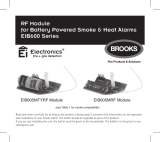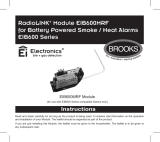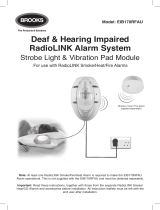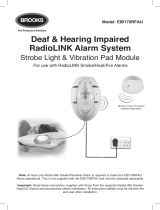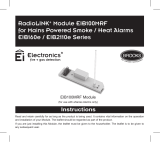Page is loading ...

1
SmartLINK Module EIB3000MRF
for Mains Powered Multi-Sensor / Smoke / Heat / CO
Alarms - EIB3000 Series
Instruction Manual
Read and retain carefully for as long as the product is being used. It contains vital
information on the operation and installation of your Alarm. The leaflet should be
regarded as part of the product.
If you are just installing the unit, the leaflet MUST be given to the householder. The
leaflet is to be given to any subsequent user.

2

3
1. Introduction 4
2. Installation and House Coding 6
3. System Installations 13
4. Additional Features 18
5. Troubleshooting and Indicator summary tables 21
6. Testing the System 28
7. Interconnected CO Alarms and Smoke Alarms 31
8. SmartLINK Troubleshooting 33
9. Technical Specifications 35
10. Guarantee 37
11. Limitations of Radio Communications 39
Contents

4
1
Introduction

5
The EIB3000MRF SmartLINK Module is the next generation RF module from Brooks designed
to fit in the EIB3000 series, Easi-fit mains powered Alarms.
The primary function of the EIB3000MRF is to wirelessly interconnect all Brooks Alarms in
a system by means of an RF signal i.e. when one Alarm senses a fire event, the EIB3000MRF
module fitted to that Alarm will transmit an RF signal that will activate the sounders in all
other RF Alarms in the system.
Other features include:
• Remote House coding, to reduce installation time for Alarm additions to existing sites.
• Data Extraction, to collect important information on the Alarm status, including
activations, tests, CO levels, faults etc.
• Monitoring (buddy system) where the strongest RF signal paths are selected between a
pair of devices as a means to monitor the RF connection.
The EIB3000MRF module is simply plugged into the rear of the base of an EIB3000 series
Alarm. RF communication via this module eliminates the need to install long interconnect
wires between all the Alarms on different floors in different rooms. The EIB3000MRF is
powered from the Alarm it is connected to.
The module also has “multiple repeater” transmission – this provides multiple signal paths
to create a robust RF ‘mesh’ system and also increase the RF range.

6
2
Installation and
House Coding

7
N.B Disconnect Mains Before Alarm Head Removal
After disconnecting the mains power supply, it is now safe to remove the Alarm from its
base. Using a screwdriver, insert into the removal slot on the side of the Alarm.
Push the lower half of the Alarm away from the screwdriver, in the direction of the arrow
on the cover (see Figure 1 below).
CAUTION: The existing hard-wired interconnection may need to be disconnected at this
point (refer to the Installation section in the Alarm instruction manual). If a hard-wired
connection and an RF connection exist between the SAME two Alarms, a continuous Alarm
loop signal may occur.
Figure 1

8
Fitting the EIB3000MRF Module
To fit the EIB3000MRF Module, first hold the flexible antenna and guide it into its designated
hole in the rear of the unit until about 2/3 of its length is inserted (Fig. 2a). Then, hold the
module housing (Fig. 2b) and plug it into the Alarm, being careful to align the pins and
keeping them perpendicular to the base as the module is inserted (Fig. 2c). Ensure the
module is fully home, by checking that it is flush with the surrounding Alarm housing (Fig.
2d).
Pin
Alignment
Pin
Alignment
Pin
Alignment
Figure 2a Figure 2b Figure 2c

9
House Coding the Unit
Re-connect the Alarm to the base. Switch back on
the mains power. Check for the green LED on the
Alarm cover. Power supply to the EIB3000MRF will
be confirmed by an initial flash of the red, blue and
green LED on the side of the unit (see Fig 3).
Using a screwdriver, press and hold the House Code
button on the side of the unit until the blue light
illuminates (see Fig 4).
Immediately release the button, the blue light will
flash rapidly and then stop.
The flashing will repeat every 5 seconds thereafter.
Repeat this procedure for all Alarms in the system.
Check to ensure all RF devices have been successfully House Coded. This can be done by
counting the number of blue flashes on each RF Module. The number of flashes should
correspond to the number of RF devices in the system. (i.e. 4 flashes if there are 4 devices
in the system). Note: If an EIB3028 Alarm is included in the system, there will be an extra
blue flash (this corresponds to the 2 independent sensors in the Alarm head). e.g with 4 RF
devices in a system, one of which is an EIB3028 you would expect 5 blue flashes during the
housecode process and so on.
Pin
Alignment
Figure 2d

10
N.B. We recommend, for ease of installation and RF communication, that up to 12
RF devices can be installed in any one RF coded system. Please contact us for further
advise if additional RF devices are required.
Figure 4
blue, red & green LED
Figure 3

11
You can exit this mode by pressing the House Code button on one of the RF Alarms. Keep the
button pressed until the blue light comes on solid and then release.
The Alarm will now send a signal to all the other RF devices in the system to exit House Code.
Alternatively, the RF Alarms will automatically exit the House Code mode after 30 minutes.
To check the system, press the test button on any Alarm. After a few seconds all Alarms
should now sound. All Alarms in the system should be checked similarly.
Caution: Do not House Code another group (e.g. adjacent apartment) until the current
House Code has been completed.
Factory Reset
Sometimes in order to resolve an RF communication issue it may be necessary to reset
(factory reset) and House Code the system again. To do so, press and hold the House Code
button until you see a flashing blue light on the Alarm cover (approx. 7 seconds), release
immediately. Repeat this procedure on all Alarms.
Removing the EIB3000MRF Module
If it is necessary to remove or replace an RF Module already fitted to an Alarm, it can be
taken out by firstly using your index finger to lift it by 5 to 6mm to release the connection
pins (Fig. 5a), repeat this process on the opposite end to release the antenna (Fig. 5b), after
which the module can be fully removed from the Alarm by lifting it away while keeping the
pins perpendicular to the Alarm (Fig. 5c).

12
Pin
Alignment
Figure 5b
Pin
Alignment
Figure 5c
Pin
Alignment
Figure 5a

13
3
System
Installations

14
Mixed Hardwired Interconnect and Wireless Interconnect (Hybrid) System
EIB3000 Series Alarms are also equipped to work in a hybrid system. A hybrid system is a
combination of hardwired interconnected and RF interconnected Alarms and devices. Hybrid
systems can be very flexible and allow extended fire and/or CO protection with minimum
installation disruption.
When a hybrid system installed and a specific alarm type (Fire or CO) is required for
separate control or indication, the interconnection between Fire and CO Alarms must be via
EIB3000MRF as shown in Figure 6 and Figure 7.

15
Hardwired
Carbon Monoxide
Alarm
EIB3018
The hardwired interconnected sections of a hybrid system should be
separated into CO only Alarms and Multi, Smoke and Heat Alarms, to ensure
that the alarm type is indicated correctly to the RF network during activation
Hardwired
Carbon Monoxide
Alarm
EIB3018
Hardwired
Carbon Monoxide
Alarm
Fire / CO
Alarm Interface
Figure 6
EIB3018
EIB413
Hardwired
Multi-Sensor
Alarm
Hardwired
Photoelectric
Smoke Alarm
EIB3024 EIB3016
Hardwired
Heat
Alarm
EIB3014
System
Alarm Controller
EiB450
RF Heat &
Carbon Monoxide
Alarm
EIB3028
The RF network of the hybrid system can consist of a mixture of
Multi, Smoke, Heat and/or CO Alarm types
Fire / CO
Alarm Interface
EIB413
System
Alarm Controller
EIB450
RF
Multi-Sensor
Alarm
EIB3024
RF
Carbon Monoxide
Alarm
EIB3016
RF
Photoelectric
Smoke Alarm
Hardwired
Carbon Monoxide
Alarm
If an EIB3028 Heat and CO Alarm is required on a hardwired section, it should
be fitted to a Multi, Smoke and Heat only section, one per section and that
EIB3028 should also be the section‘s link to the RF network of the hybrid system
Fire / CO
Alarm Interface
EIB413
RF
Heat
Alarm
EIB3014
EIB3016
Hardwired
Photoelectric
Smoke Alarm
EIB3018
RF
Heat
Alarm
EIB3014
RF Heat &
Carbon Monoxide
Alarm
EIB3028
EIB3018
Figure 7
Examples of various RF and Hardwired Systems

16
Hardwired
Carbon Monoxide
Alarm
EIB3018
The hardwired interconnected sections of a hybrid system should be
separated into CO only Alarms and Multi, Smoke and Heat Alarms, to ensure
that the alarm type is indicated correctly to the RF network during activation
Hardwired
Carbon Monoxide
Alarm
EIB3018
Hardwired
Carbon Monoxide
Alarm
Fire / CO
Alarm Interface
Figure 6
EIB3018
EIB413
Hardwired
Multi-Sensor
Alarm
Hardwired
Photoelectric
Smoke Alarm
EIB3024 EIB3016
Hardwired
Heat
Alarm
EIB3014
System
Alarm Controller
EiB450
RF Heat &
Carbon Monoxide
Alarm
EIB3028
The RF network of the hybrid system can consist of a mixture of
Multi, Smoke, Heat and/or CO Alarm types
Fire / CO
Alarm Interface
EIB413
System
Alarm Controller
EIB450
RF
Multi-Sensor
Alarm
EIB3024
RF
Carbon Monoxide
Alarm
EIB3016
RF
Photoelectric
Smoke Alarm
Hardwired
Carbon Monoxide
Alarm
If an EIB3028 Heat and CO Alarm is required on a hardwired section, it should
be fitted to a Multi, Smoke and Heat only section, one per section and that
EIB3028 should also be the section‘s link to the RF network of the hybrid system
Fire / CO
Alarm Interface
EIB413
RF
Heat
Alarm
EIB3014
EIB3016
Hardwired
Photoelectric
Smoke Alarm
EIB3018
RF
Heat
Alarm
EIB3014
RF Heat &
Carbon Monoxide
Alarm
EIB3028
EIB3018
Figure 7

17
Hardwired
Carbon Monoxide
Alarm
EIB3018
The hardwired interconnected sections of a hybrid system should be
separated into CO only Alarms and Multi, Smoke and Heat Alarms, to ensure
that the alarm type is indicated correctly to the RF network during activation
Hardwired
Carbon Monoxide
Alarm
EIB3018
Hardwired
Carbon Monoxide
Alarm
Fire / CO
Alarm Interface
Figure 6
EIB3018
EIB413
Hardwired
Multi-Sensor
Alarm
Hardwired
Photoelectric
Smoke Alarm
EIB3024 EIB3016
Hardwired
Heat
Alarm
EIB3014
System
Alarm Controller
EiB450
RF Heat &
Carbon Monoxide
Alarm
EIB3028
The RF network of the hybrid system can consist of a mixture of
Multi, Smoke, Heat and/or CO Alarm types
Fire / CO
Alarm Interface
EIB413
System
Alarm Controller
EIB450
RF
Multi-Sensor
Alarm
EIB3024
RF
Carbon Monoxide
Alarm
EIB3016
RF
Photoelectric
Smoke Alarm
Hardwired
Carbon Monoxide
Alarm
If an EIB3028 Heat and CO Alarm is required on a hardwired section, it should
be fitted to a Multi, Smoke and Heat only section, one per section and that
EIB3028 should also be the section‘s link to the RF network of the hybrid system
Fire / CO
Alarm Interface
EIB413
RF
Heat
Alarm
EIB3014
EIB3016
Hardwired
Photoelectric
Smoke Alarm
EIB3018
RF
Heat
Alarm
EIB3014
RF Heat &
Carbon Monoxide
Alarm
EIB3028
EIB3018
Figure 7

18
4
Additional Features

19
The EIB3000MRF SmartLINK Module provides a range of exciting new additional features:
1. Remote House Coding (if you want to add or replace an Alarm to an installed system)
If it is necessary to extend an RF system or you find that you want to add an extra Alarm to a
system you can now do so quite simply via the ‘Remote House Coding’ feature. Firstly using a
screwdriver, press and hold the House Code button of one of the previously installed Alarms
until you see all colours flashing - red, blue, green (typically takes about 8 seconds) and then
release. This Alarm will now send an RF message to all the previously installed (compatible)
devices to re-enter House Code mode. Similarly, install and put the new Alarm you wish to
add to the system into House Code mode (see “Installation and House Coding” section). As
before, allow sufficient time so that all Alarms are now house coded correctly (this can be
confirmed by counting the number of flashes on each Alarm). You can then exit House Code
mode manually or let it exit automatically after 30 minutes. (N.B. for this feature to work all
devices in the system must be SmartLINK or RadioLINK+).
2. Data Extraction
The EIB3000MRF SmartLINK Module allows for the extraction of certain information from
an EIB3000 Series Alarm, using a Brooks download device. Once the system has been set up,
information can be accessed from within or outside a property (within RF range) if access is
an issue. This data is displayed as an event log and contains very useful information about
any recorded events in the history of the Alarm such as: Fire Events, Alarm Head removals,
Button Tests, CO levels and so on.
Event logs can be retrieved as many times as necessary and can be stored on your tablet,
Laptop or PC as a record of the status of the installation.
For more information on this feature please contact us directly.

20
3. Monitoring (Buddy System)
The EIB3000MRF SmartLINK Module facilitates a simple monitoring or buddy system between
the Alarms. The system must first be successfully house coded. Then to enable Monitoring,
hold the House Code Button of one Alarm only until the green LED lights solid (typically
takes about 12 seconds) and then release. Each Alarm will “pair” with the strongest signal
than it has received during the house coding process. When successfully paired the LED will
flash blue-green. If the LED flashes blue-red, then pairing has failed. Try re-orientating the
Alarm heads or adding extra RF devices to improve the range. Then re-house code the system
and re-start the monitoring process again. To exit Monitoring mode, hold the House Code
Button until the green LED lights solid and then release. Alternatively, it will automatically
exit monitoring mode after 30 minutes.
Monitoring is now enabled in the network. If a paired Alarm then loses the signal from its
buddy, it will flash red-blue for 10 minutes (this can also be seen after a button test).
To disable monitoring, hold the House Code Button until the red LED lights solid and then release.
Note: A monitoring failure does not necessarily mean that the RF signal cannot be propagated
through the RF mesh network. Multiple path communication, via the mesh architecture,
ensures that the signal could be propagated through alternative signal paths to ensure the
required communication.
4. Live Monitoring
The EIB3000MRF SmartLINK Module, together with the EIB1000G Gateway and the
proprietary Cloud portal, delivers a unique “live monitoring” of the installation.
For more information on this feature please contact us directly.
/



